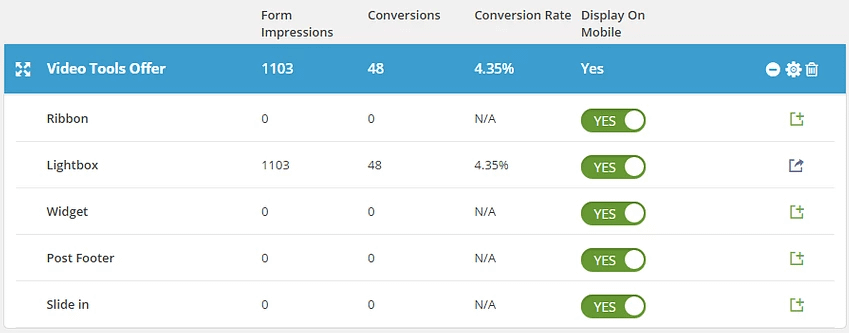In order to make business decisions based on facts, you need to have data but also an understanding of exactly how the data is collected and what it means.
I also want to take some time to explain why we’ve decided to collect data in this way.
In the Thrive Leads Dashboard (Visitor Centric Stats)

In the top portion of the dashboard, you have “today’s summary”.
These stats are visitor-centric. Here is what this data is telling you:
- Unique Impressions – How many visitors did I have to my site today that haven’t visited my site before in the past 30 days? If they have visited your site in the last 30 days, then they are not counted as a unique impression as it is a repeat visit and the impression has already been tracked against the day of the original hit.
- Conversions – The number of people that have submitted their details through a Thrive Leads opt-in form in the current day. *see note below about server times
- Conversion Rate – the conversions expressed as a percentage of unique impressions.
Note: We don’t control the time and date settings on your server, therefore the “current day” may not actually match the time zone that you’re living in. For instance, if you live in the UK, but are hosted on a server that’s based in America, then you may see a time discrepancy of 5 – 8 hours between the time in your locality and the current time on your server.
Today’s summary is telling you how many “new” visitors to your site you have received and how many new signups you’ve received in that same time frame expressed absolutely and as a percentage. Here are some technicalities:-
- Scenario: a user visited your site 10 days ago and didn’t sign up. The user returns to your site today and signs up.
Result: The unique impression is recorded against the day of the original hit, but the conversion is recorded today.
- Scenario: a user visited your site 40 days ago and signed up. The visitor returns today and signs up again.
Result: both a unique impression and a conversion is logged in today’s data.
The most important thing to remember about “Today’s Summary” is that the statistics are visitor-centric. It gives you a snapshot of performance in relation to the number of unique visitors that visit your site.
This is the most important metric. Everything built-in Thrive Leads is designed to help you improve your site-wide visitor to sign up ratio and all of our decisions have been based on helping you achieve this end goal.
Lead Group Statistics

The statistics here will not match up with the statistics shown in “Today’s Summary” because these statistics are form centric as opposed to visitor-centric.
Each impression in this table is based on whether a form meets the “display settings” criteria.
As an example, let’s say we created a lead group and set the display settings such that the lead group should show on “all posts”. We then added a lightbox, ribbon, and a post-footer to the lead group. Each time a post is loaded, 3 impressions will be tracked, 1 against each of the form types, even though only 1 visitor has viewed the content.
This is the important difference between visitor-centric statistics and form centric statistics.
Why Do We Have Both Visitor Centric and Form Centric Statistics?
As we mentioned above, the bottom line goal of Thrive Leads is to improve your site-wide visitor to signup conversion rate.
In order to do this, we need to capture data at form level in order to give split testing capability and understand which forms are performing the best on the site.
Consistent iterative improvements to the conversion rate at form level will lead to a significantly higher site-wide visitor conversion rate.
Does a Form Actually Have to be Displayed for an Impression to be Tracked?
No.
For example: if you added a lightbox to a lead group and set the trigger to “appear after 30 seconds” then an impression is logged even if that form doesn’t appear.
It’s really important that this is understood, especially in the context of split testing.
We made a deliberate decision to log impressions in this way. Simply, the conversion performance of a form should encompass everything:- design, triggers, and any other settings attached to it.
To explain why let’s use an example:
- We set up a lightbox to display instantly on page load (lightbox A) and a variation after 30 seconds (lightbox B).
- Both variations receive 2000 visitors.
- The lightbox set to display instantly gets 200 conversions. The form was displayed to all 2000 visitors.
- The lightbox set to display after 30 seconds captured 50 conversions. It was only seen by 100 people (because nobody else stayed longer than 30 seconds).
Which lightbox would you prefer to have on your site?
Obviously, the answer is lightbox A, because for the same number of traffic (2000 visitors) lightbox A successfully converted 100 more people than lightbox B. Ultimately, it’s a higher-performing blend of design and trigger and therefore performs better on the site.
However, if we tracked impressions only when a form is viewed, Lightbox B would be the clear winner. With a conversion rate of 50%, against 10% of Lightbox A, it would be the clear winner in any split test.
That’s why we have to be careful and always count impressions, even if the settings determine that the form isn’t displayed (due to a trigger that isn’t triggered, or a location that doesn’t exist in the given context).
In short: Settings that determine the display are part of the test and have to be in order to ensure that the conversion rate gives a meaningful result in the context of maximizing visitor signups.